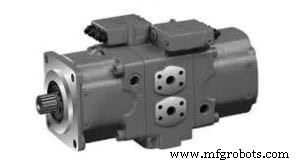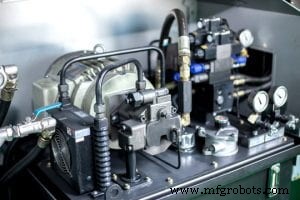Yang menentukan kecepatan motor hidrolik
Saat Anda ingin memindahkan sesuatu dengan motor hidrolik, Anda perlu mengetahui dua hal:kecepatan fluida (dalam meter per detik) dan kecepatan motor (dalam meter per detik). Dalam artikel ini, kita akan berfokus pada kecepatan motor dan melihat pengaruhnya terhadap kecepatan fluida.
Motor Listrik
Motor listrik bekerja berdasarkan prinsip induksi elektromagnetik. Motor listrik yang berputar terdiri dari sejumlah elektromagnet, satu untuk setiap kutub. Ketika arus listrik melewati elektromagnet, mereka menjadi magnet dan akan berputar di sekitar sumbunya sendiri berlawanan satu sama lain. Ini menciptakan gaya rotasi yang dapat dimanfaatkan untuk menggerakkan motor listrik. Kecepatan motor ditentukan oleh seberapa banyak arus yang dapat dibawanya dan ukuran elektromagnet.

motor hidrolik
Pompa Oli atau Pelat Pelumas Oli
Ada banyak perdebatan tentang apa yang menentukan kecepatan motor hidrolik. Beberapa orang mengatakan bahwa pompa oli menentukan kecepatan, sementara yang lain mengatakan bahwa pelat percikan oli menentukan kecepatan. Kedua teori tersebut memiliki beberapa bukti untuk mendukungnya, tetapi tidak ada yang benar secara pasti.
Teori pompa oli didasarkan pada fakta bahwa RPM yang lebih tinggi memerlukan aliran oli yang lebih tinggi melalui pompa. Ini pada gilirannya berarti pompa akan bekerja lebih keras dan oleh karena itu, motor akan bekerja lebih cepat.
Namun, ada beberapa faktor lain yang juga dapat mempengaruhi kecepatan motor hidrolik. Misalnya, jika ada kotoran di saluran oli atau jika motor rusak, motor tidak dapat berfungsi secara efisien dan ini akan memperlambatnya. Selain itu, suhu juga dapat memengaruhi seberapa cepat motor bekerja – semakin dingin, semakin lambat motor berjalan.
Pada akhirnya, tidak mungkin untuk menentukan dengan tepat seberapa cepat motor hidrolik berjalan tanpa memeriksanya secara langsung. Namun, dengan memahami bagaimana berbagai faktor dapat memengaruhi kecepatannya, Anda dapat memastikannya beroperasi pada performa terbaiknya.
Kecepatan motor hidrolik
Motor hidrolik biasanya lebih cepat daripada motor listrik karena cairan hidrolik dapat bergerak lebih cepat. Selain itu, motor hidrolik tidak perlu berputar berkali-kali untuk mendapatkan hasil yang sama seperti motor listrik.
Namun, motor hidrolik juga bisa kurang bertenaga dibandingkan motor listrik. Ini karena motor hidrolik tidak memiliki jumlah tenaga yang sama dengan motor listrik untuk menghasilkan torsi.
Motor hidrolik bekerja dengan menggunakan cairan bertekanan untuk memutar poros. Poros ini kemudian dapat digunakan untuk memindahkan objek atau melakukan tugas.
Cairan bertekanan dapat berasal dari reservoir atau dapat disuplai oleh mesin. The reservoir is typically filled with oil, water or some other type of fluid.
When the hydraulic motor is powered, the pressurized fluid is forced into the engine. This causes the engine to turn and create torque. The torque causes the shaft to rotate and move the object or perform the task.
Compression of the Oil
A hydraulic motor’s speed is determined by how much compression the oil can withstand before it ruptures. The higher the compression, the faster the motor will operate.
Oil compression is measured in psi (pounds per square inch). The higher the psi, the more pressure the oil can withstand before it ruptures.
The maximum oil compression that a hydraulic motor can withstand is around 3000 psi.
If the oil reaches a certain psi level, it can rupture. This can happen suddenly, causing the motor to stop abruptly. Or it can happen over time, with the oil gradually breaking down and becoming unable to withstand the pressure.
Either way, rupture of the oil can be dangerous and lead to a loss of engine power. So it’s important to keep an eye on your oil pressure and make sure it stays within safe limits.
The Output Torque of the Motor
When you buy a motor, it’s important to know the output torque. Output torque is what allows the motor to do its job, and it’s measured in inch-pounds. The higher the output torque, the faster the motor can move objects.
There are a few things that affect output torque. One is the size of the motor. Larger motors have more output torque than smaller motors. Another factor is how quickly the motor can turn. A fast motor has more output torque than a slow motor.
The final factor that affects output torque is the type of fluid inside the motor. Fluids with low viscosity (a thick liquid) have more output torque than fluids with high viscosity (a thin liquid). This is because a low viscosity fluid can flow through a smaller diameter pipe faster than a high viscosity fluid can.
hydraulic motor displacement
A hydraulic motor can be thought of as a piston in a cylinder. The piston is connected to a rotating shaft, and the cylinder is filled with pressurized fluid. The pressure in the cylinder drives the piston, which in turn rotates the shaft.
The size of the piston determines how fast the motor will spin. A small piston will move around quickly, while a large piston will move more slowly. The speed of the motor also depends on how much fluid is inside the cylinder and how tightly the piston is connected to the shaft.
pressure of the oil in the system
The speed of a hydraulic motor is determined by the pressure of the oil in the system. The higher the pressure, the faster the motor will run.
The amount of pressure needed to run a hydraulic motor depends on the type of motor and the size of the system. Typical pressures for various types of motors can be found on the manufacturer’s website. For systems up to 10,000 lb (4,500 kg), a pressure of 40 psi (275 kPa) is typically used. Systems larger than 10,000 lb (4,500 kg) may require higher pressures, such as 50 psi (340 kPa).
esistance to the load being moved
hydraulic motors are typically rated by the number of pounds of pressure that their cylinders can produce. The higher the pressure, the faster the motor will move the load. However, there are other factors that also play a role in how quickly a motor moves a load, such as shaft size and design, number of gears, and motor construction materials.

hydraulic motor
Conclusion
In this article, we will explore the different factors that determine the speed of a hydraulic motor. We will start by looking at the flow rate and pressure drop in a hydraulic system. We will then look at the power input and output of a hydraulic motor, and finally discuss how these factors affect the speed of a hydraulic motor. Hopefully, this article has helped you better understand how to calculate the speed of a hydraulic motor.





